How to Plant Potatoes: Tips for a Bountiful Harvest
- February 1, 2024
- 0 comment
Potatoes are a versatile and staple crop in many households, loved for their rich taste and myriad culinary possibilities. Whether you’re a seasoned gardener or a novice with a green thumb, cultivating potatoes can be a rewarding and straightforward endeavor. In this guide, we’ll provide you with step-by-step instructions and valuable tips to ensure a bountiful potato harvest.

Benefits of Potatoes
| Benefit | Description |
|---|---|
| Nutrient-Rich: | Potatoes are a good source of essential nutrients, including vitamin C, potassium, vitamin B6, and dietary fiber. These nutrients contribute to overall health and well-being. |
| Energy Source: | Potatoes are an excellent source of carbohydrates, providing a quick and easily digestible energy source, making them a valuable component of a balanced diet. |
| Dietary Fiber: | The skin of potatoes is rich in dietary fiber, promoting digestive health, regulating bowel movements, and supporting a healthy gut microbiome. |
| Vitamin C: | Potatoes contain vitamin C, an antioxidant that helps boost the immune system, supports collagen formation for healthy skin, and aids in the absorption of iron from plant-based foods. |
| Potassium: | Potatoes are a good source of potassium, a mineral that plays a crucial role in maintaining proper heart and muscle function, regulating blood pressure, and balancing fluid levels. |
| B-Vitamins: | Potatoes, particularly when consumed with the skin, provide essential B-vitamins, including B6, which is important for brain development and function, and folate, crucial for DNA synthesis and cell growth. |
| Antioxidants: | Potatoes contain various antioxidants, such as flavonoids and carotenoids, which help protect the body’s cells from oxidative stress and inflammation. |
| Blood Pressure Regulation: | The potassium content in potatoes contributes to maintaining healthy blood pressure levels by counteracting the effects of sodium in the body. |
| Weight Management: | Despite misconceptions, when prepared in a healthy manner (e.g., baked or boiled), potatoes can be a satisfying and filling food, potentially aiding in weight management by reducing overall calorie intake. |
| Versatility in Cooking: | Potatoes are incredibly versatile and can be prepared in numerous ways, offering a wide range of culinary options to suit various tastes and preferences. |
It’s important to note that while potatoes offer numerous health benefits, the method of preparation (e.g., frying or loading with unhealthy toppings) can impact their nutritional profile. Opting for healthier cooking methods, such as baking, boiling, or roasting, helps retain the nutritional value of potatoes.
Choosing the Right Potato Variety
Before you start planting, it’s crucial to choose the right potato variety for your region and desired use. There are numerous types of potatoes, each with its unique characteristics, flavors, and optimal growing conditions. Some popular varieties include Russet, Yukon Gold, and Red Pontiac. Consider the taste, texture, and cooking qualities that suit your preferences.
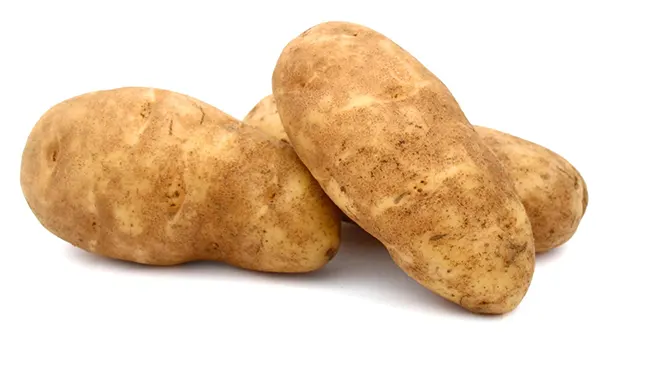
Russet Potatoes
Characteristics: Russets are known for their high starch content, which makes them ideal for baking, mashing, and frying. They have a dry and fluffy texture when cooked.
Best Use: Baked potatoes, mashed potatoes, french fries, and hash browns.
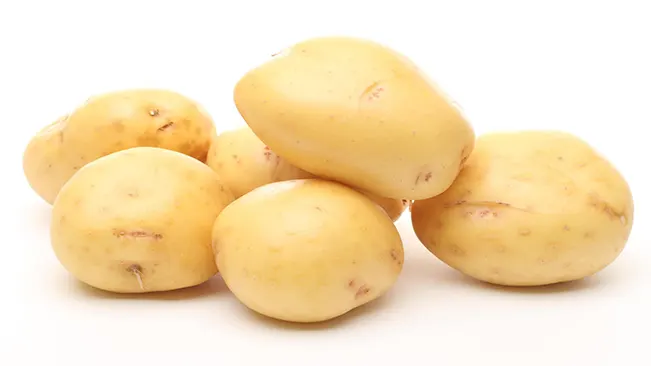
Yukon Gold
Characteristics: Yukon Gold potatoes have a buttery flavor and a creamy texture. They are versatile and work well in various cooking methods.
Best Use: Roasting, boiling, mashing, and salads
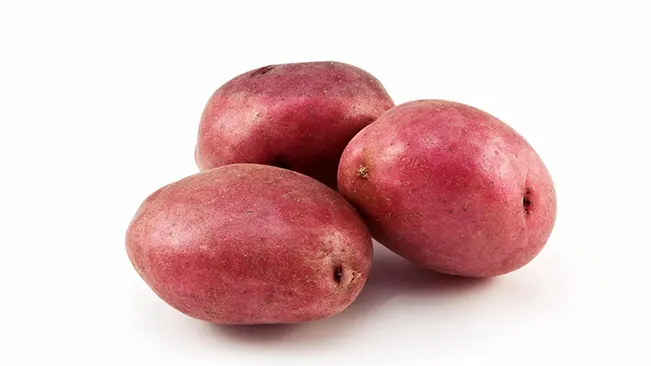
Red Potatoes
Characteristics: Red potatoes have a waxy texture and thin red skin. They hold their shape well during cooking, making them suitable for salads and roasting.
Best Use: Potato salads, roasting, boiling, and casseroles.
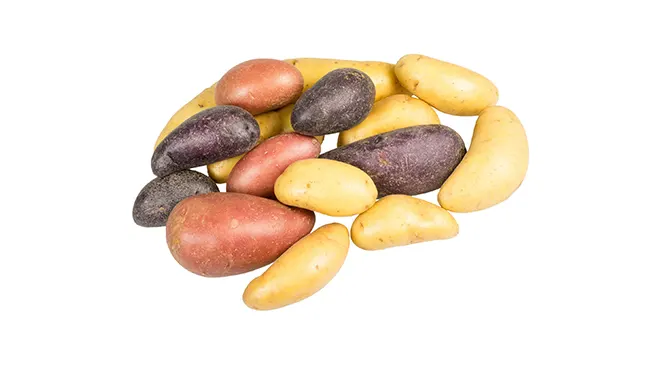
Fingerling Potatoes
Characteristics: Fingerlings are small, elongated potatoes with a firm and waxy texture. They come in various colors and offer a unique flavor profile.
Best Use: Roasting, grilling, and adding to salads.
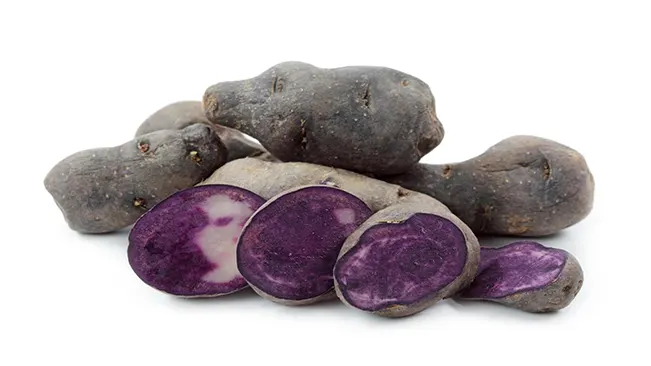
All Blue Potatoes
Characteristics: These potatoes have a vibrant blue or purple flesh and skin. They are rich in antioxidants and have a slightly nutty flavor.
Best Use: Mashing, roasting, and adding a colorful touch to dishes.
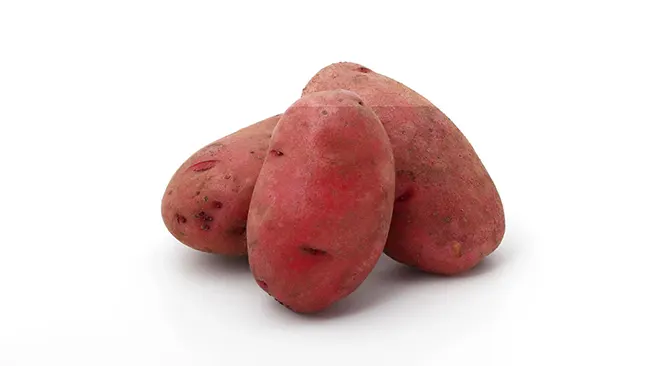
Adirondack Red and Adirondack Blue
Characteristics: These varieties have red and blue/purple flesh, respectively. They are visually striking and offer a distinct taste.
Best Use: Mashing, roasting, and adding color to dishes.
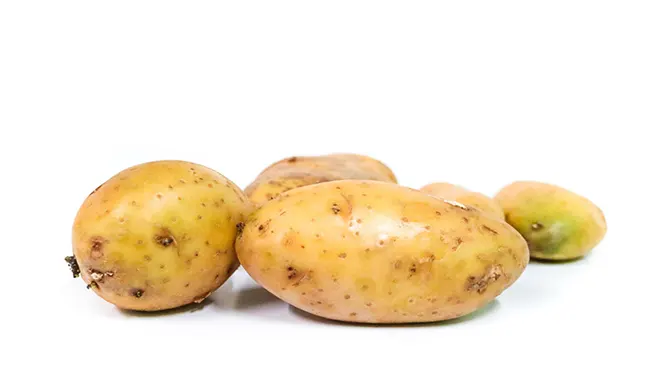
Katahdin Potatoes
Characteristics: Katahdin potatoes have smooth, tan skin and white flesh. They are versatile and suitable for various cooking methods.
Best Use: Baking, boiling, and mashing.
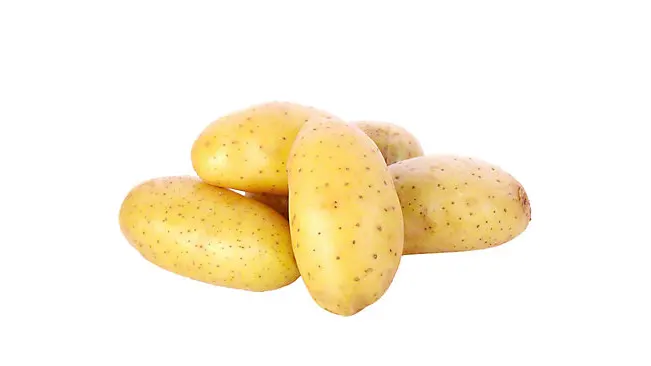
Kennebec Potatoes
Characteristics: Kennebecs have thin, light tan skin and white flesh. They are known for their excellent taste and texture.
Best Use: Baking, frying, and making potato chips.
Preparing the Soil and Planting Potatoes
Potatoes thrive in well-draining, loose soil with a slightly acidic to neutral pH. Begin by clearing the planting area of weeds, rocks, and debris. Loosen the soil to a depth of at least 8-10 inches, breaking up any clumps. Adding organic matter like compost or well-rotted manure will enhance soil fertility and improve drainage.
Clearing the Planting Area
Before you start preparing the soil, clear the designated planting area of any unwanted vegetation, rocks, and debris. Weeds can compete with potatoes for nutrients and may host pests or diseases.

Loosening the Soil
Using a shovel or a garden fork, loosen the soil to a depth of at least 8-10 inches. This deep loosening allows the potato roots to penetrate easily and encourages healthy tuber development. Break up any large clumps of soil to create a fine, crumbly texture.
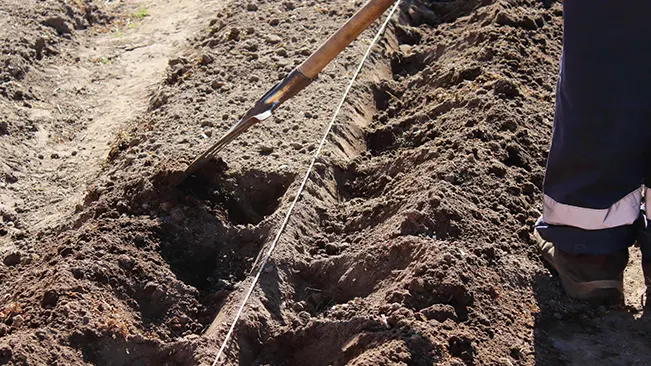
Improving Drainage
Potatoes prefer well-draining soil to prevent waterlogging, which can lead to root rot. If your soil has drainage issues, consider incorporating organic matter such as compost or well-rotted manure. This not only improves drainage but also enhances soil structure.
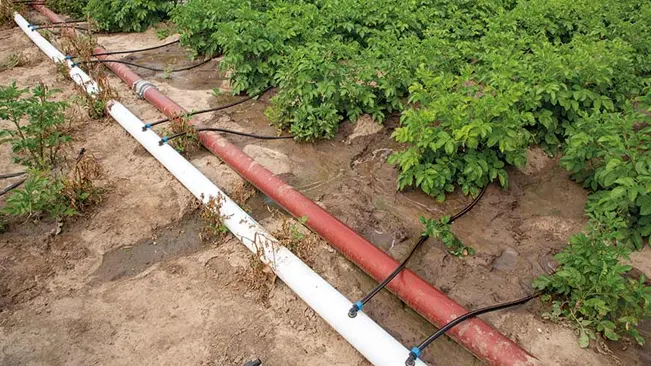
Adjusting pH Levels
Potatoes thrive in slightly acidic to neutral soil with a pH range of 5.8 to 7.0. Test the soil pH using a soil testing kit. If the pH is too low (acidic) or too high (alkaline), you can adjust it by adding lime to raise the pH or elemental sulfur to lower it.
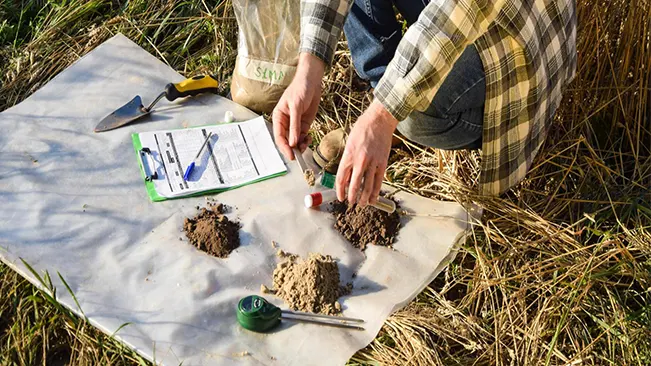
Mulching
Consider applying a layer of organic mulch, such as straw or shredded leaves, over the soil surface. Mulching helps to retain moisture, suppress weeds, and regulate soil temperature. It also provides a protective layer for developing potatoes.

Watering
Before planting, water the prepared soil to ensure it is adequately moist. Proper moisture levels are essential for seed potato sprouting and initial root development.
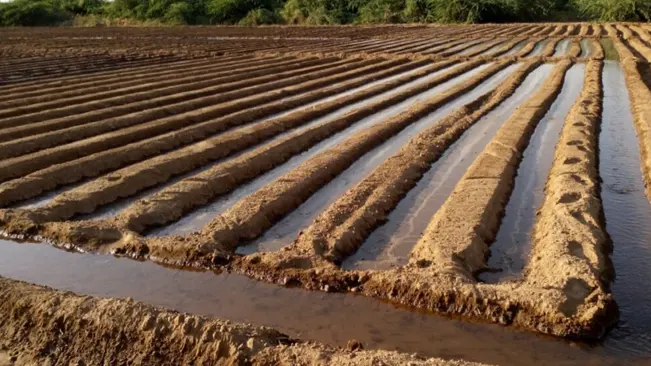
Adding Organic Matter
Enhance the fertility of the soil by incorporating organic matter like compost or well-rotted manure. Organic matter provides essential nutrients for the potatoes and promotes beneficial microbial activity in the soil. Work the organic matter into the soil evenly using a rake or garden fork.
Potatoes are typically grown from seed potatoes, which are small tubers saved from the previous year’s crop. Cut the seed potatoes into sections, ensuring that each piece has at least one “eye” – the small indentation from which sprouts will emerge. Allow the cut pieces to air dry for a day or two before planting.
Caring for Potato Plants
Potatoes require consistent care to thrive and produce a bountiful harvest. Here are some essential tips for nurturing your potato plants:
- Watering: Keep the soil consistently moist, especially during the crucial growing periods. However, avoid overwatering, as potatoes are susceptible to rot in waterlogged conditions.
- Hilling: As potato plants grow, gradually mound soil around the base to cover the emerging tubers. This process, known as hilling, prevents the potatoes from being exposed to sunlight, which can turn them green and produce a bitter taste.
- Fertilizing: Potatoes benefit from a balanced fertilizer with higher potassium content. Apply fertilizer when planting and again when the plants are 6-8 inches tall.
- Mulching: Mulch around the plants to conserve moisture, suppress weeds, and regulate soil temperature. This is particularly important in warmer climates.
Harvesting
Potatoes are ready for harvest when the plants flower and the foliage begins to yellow and die back. Carefully dig around the base of the plant to unearth the potatoes. Be gentle to avoid damaging the tubers. Allow the harvested potatoes to cure in a cool, dark place for about two weeks before storing them in a cool, dry environment.
When to Harvest
Observing the Foliage
Monitor the potato plants as they grow. Potatoes are usually ready for harvest when the foliage turns yellow and begins to die back. The yellowing and withering of the leaves indicate that the plants are redirecting energy from foliage growth to the development of tubers.

Blooming Period
Another sign that potatoes are ready for harvest is when the plants enter their blooming period. However, not all potato varieties produce flowers, so relying solely on this cue might not be universal.
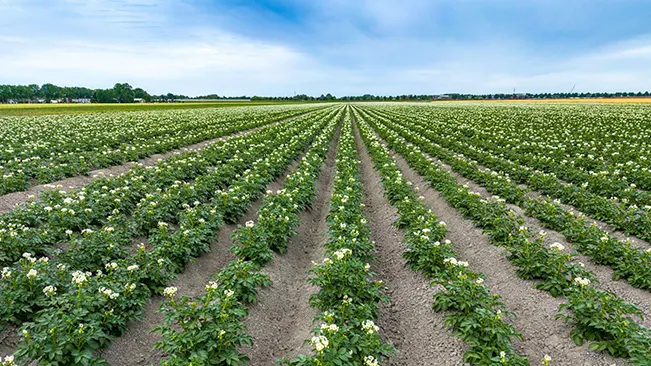
Test Harvest
If you’re unsure about the readiness of your potatoes, you can perform a test harvest. Carefully dig up a few plants and examine the tubers. Mature potatoes should have a firm skin, and the size will depend on the variety.
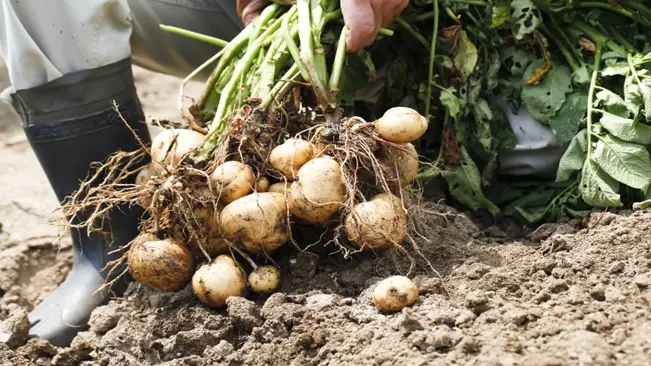
How to Harvest
Use a Fork or Shovel
To avoid damaging the potatoes, use a garden fork or shovel to gently loosen the soil around the base of the plants. Start digging at a distance of about 12 inches from the plant to avoid accidentally cutting or damaging the tubers.
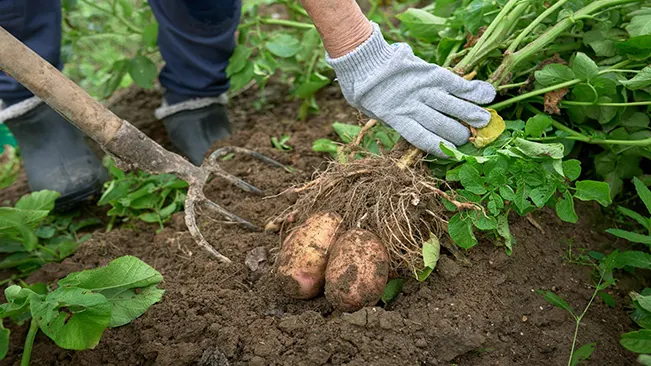
Handle with Care
Potatoes can be sensitive, so handle them with care during the harvesting process. Avoid bruising or cutting the tubers with your tools.

Collecting the Harvest
Once you’ve loosened the soil, carefully lift the plants from the ground. Shake off excess soil but avoid washing the potatoes at this stage, as it can reduce their storage life.
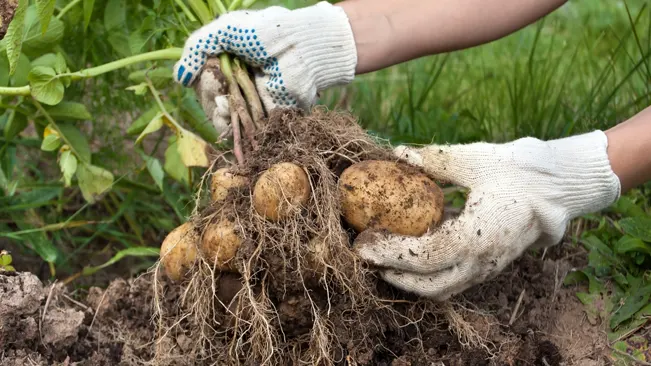
Curing
After harvesting, allow the potatoes to cure for about two weeks. Place them in a cool, dark, and well-ventilated area, like a cellar or garage. Curing helps the skin to set and any minor injuries to heal, enhancing the potatoes’ storage potential.

Storing Potatoes
Inspect for Damage
Before storing, inspect each potato for damage or signs of disease. Discard any potatoes that appear diseased or damaged.

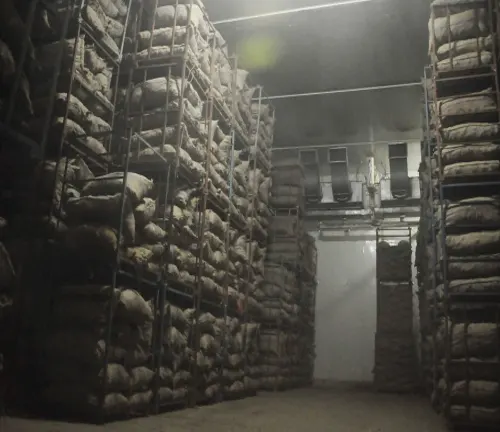
Storage Conditions
Store potatoes in a cool, dark, and well-ventilated place. Ideally, the temperature should be around 45-50°F (7-10°C). Keep potatoes away from onions, as they release gases that can accelerate sprouting.
Avoid Refrigeration
While potatoes like cool temperatures, refrigeration is not suitable. Cold temperatures can convert the starches in potatoes into sugars, affecting their taste.
Regular Check-ups
Periodically check stored potatoes for any signs of sprouting, rot, or disease. Remove any damaged potatoes to prevent the spread of issues.
Conclusion
Growing your own potatoes is a satisfying and rewarding experience that can result in a bountiful harvest of delicious tubers. By choosing the right variety, preparing the soil, and providing proper care, you can enjoy the taste of freshly harvested potatoes straight from your garden. Follow these tips, and soon you’ll be savoring the fruits of your labor in a variety of culinary delights. Happy planting!
FAQs (Frequently Asked Questions)
- When is the best time to plant potatoes?
Potatoes are typically planted in early spring, when the soil has warmed up and there is no longer a risk of frost. In colder climates, planting can be delayed until late spring. - How do I chit potatoes, and is it necessary?
Chitting involves allowing seed potatoes to sprout before planting. Place potatoes in a cool, well-lit area with the eyes facing upward for a few weeks before planting. While not mandatory, chitting can promote stronger sprouts and earlier harvests. - What type of soil do potatoes prefer?
Potatoes thrive in well-draining soil with a pH between 5.8 and 6.5. Loose, sandy loam enriched with organic matter, such as compost, is ideal for encouraging healthy tuber development. - How deep should I plant potatoes?
Plant potatoes about 4-6 inches deep in the soil. Place the seed potatoes with the sprouts facing upward to ensure proper growth. - How far apart should I space my potato plants?
Space potato plants approximately 12-15 inches apart in rows or mounds. This allows for proper air circulation and room for the plants to grow and produce tubers. - Why is hilling important, and how often should I do it?
Hilling involves piling soil around the base of the potato plants as they grow. This protects developing tubers from sunlight, preventing them from turning green. Hilling should be done regularly throughout the growing season. - How much water do potatoes need?
Potatoes require consistent moisture, especially during dry periods. Water the plants regularly, ensuring the soil remains evenly moist. However, avoid overwatering, as waterlogged soil can lead to diseases. - Can I grow potatoes in containers?
Yes, potatoes can be grown in containers. Choose large containers with good drainage and plant the seed potatoes about 4 inches deep. As the plants grow, add more soil to cover the stems, mimicking the hilling process. - What pests and diseases should I watch out for when growing potatoes? Common pests include Colorado potato beetles and aphids. Keep an eye on the foliage for signs of infestation and use organic insecticides or natural predators to control them. Rotate crops annually to minimize the risk of soil-borne diseases.
- When is the right time to harvest potatoes?
Potatoes are typically ready for harvest when the plants have flowered, and the foliage begins to yellow and die back. Gently dig around the plants to unearth the tubers. Allow harvested potatoes to cure in a cool, dark place for about two weeks before storage.

Kristine Moore
Forestry AuthorI'm Kristine Moore, a seasoned garden landscaping professional with over 30 years of experience. My extensive career has been dedicated to transforming outdoor spaces into stunning, sustainable landscapes. With a deep understanding of horticulture, design principles, and environmental stewardship, I have become a respected figure in the field, known for creating harmonious, visually appealing, and eco-friendly gardens. My commitment to excellence and continuous learning in landscaping trends and techniques has solidified my reputation as an expert in garden design and implementation.


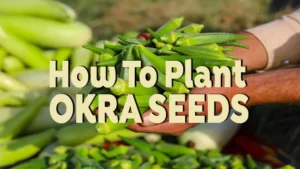
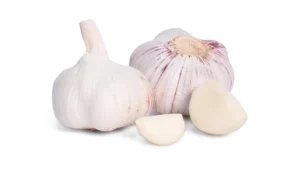
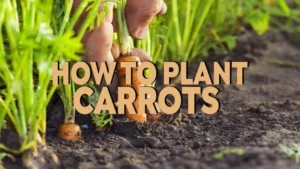
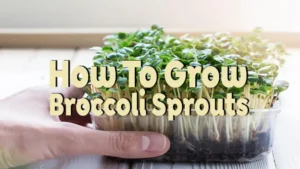
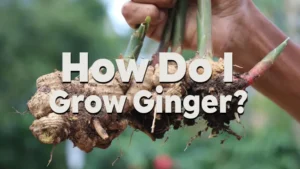
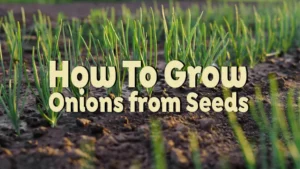

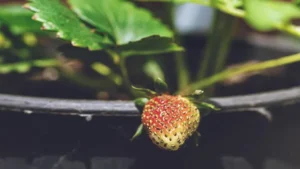
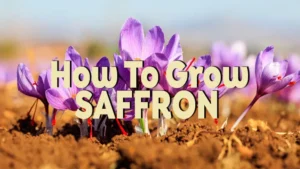
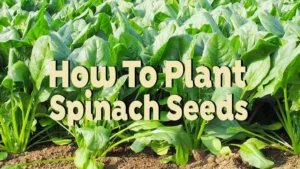
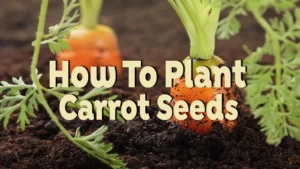
Leave your comment